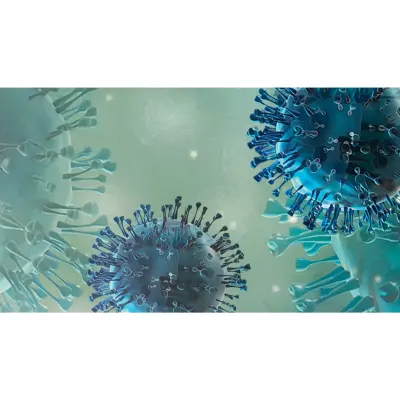Background
With more than 200 million people infected with SARS-CoV-2 and about 4.8 billion vaccine doses administered,11,12 there is a critical and urgent need to identify surrogate markers, e.g., antibody levels or titers, that correlate with immune protection from SARS-CoV-2 breakthrough infection or reinfection to maximize the benefits of COVID-19 vaccines.13,14 In regions and countries where vaccines are in short supply, correlates of protection may allow prioritizing vaccine administration and optimizing dosing schedules to achieve broader population protection.15,16 For people who received vaccines, correlates of protection can help to evaluate if individuals have developed optimal immune responses, especially in high-risk populations such as elderly individuals and immunocompromised patients,17 or may need additional booster(s). In addition, since immune responses wane over time, correlates of protection will indicate who and when people may need to be revaccinated or receive a booster to maintain immune protection.18
Circulating antibody levels or titers are used to indicate
vaccination or immune protection in infectious diseases.19
An antibody threshold is used to determine protection with the
hepatitis B vaccine20 and a correlation of hemagglutinationinhibition (HAI) antibody titer with 50%, 80% or 90% protection
can be established for influenza vaccines.21,22 Serological antibody
levels or titers may serve as a promising biomarker to assess the
immune protection of the COVID-19 vaccine to help maximize the
benefits of these vaccines globally.
Neutralizing antibodies are a key mechanism of immune protection
Adaptive immunity is a combined outcome of both cellular and humoral (antibody) immune responses,23 and antibodies serving as the frontline of protection are the hallmark of the humoral immune response.24 Neutralizing antibodies are a subset of antibodies often against the viral surface proteins.25 SARS-CoV-2 infects human cells using the Spike (S) protein, which consists of S1 and S2 subunits.26 The S1 subunit contains a receptor-binding domain (RBD) that can specifically bind to angiotensin-converting enzyme 2 (ACE2) on host cells and trigger the infection.26 Neutralizing antibodies, particularly long-lasting Immunoglobulin G (IgG), that inhibit the binding of S1/RBD to ACE2 and block viral infection and replication represent a key mechanism of immune protection.24,27
Monoclonal antibodies to the S1 protein that exhibit neutralizing
activities have been developed and proved to be effective
therapeutics for COVID-19 patients.28,29 Neutralizing antibodies
to the S protein are the key active ingredients of convalescent
plasma used to treat severe COVID-19 patients.30 Almost all
COVID-19 vaccines target the S protein with the goal to induce
neutralizing antibodies to prevent SARS-CoV-2 infection.31 In
addition, several clinical studies showed that neutralizing antibody
levels or titers correlated with immune protection.27 All these
observations suggest that anti-S neutralizing antibodies represent
a key mechanism of vaccine-induced immune protection.
Neutralizing antibodies are typically measured by biological
assays mimicking viral infection in cultured cells.32 The plaque
reduction neutralization test (PRNT) is the classical test for
measuring neutralizing antibody titers33 and pseudo viral
neutralization tests are also commonly used.34 However,
neutralization tests are time-consuming, labor-intensive and not
suitable for scaled-up routine testing in large populations.33,34
Studies have shown that some serological tests targeting the
S1 subunit or the RBD of the SARS-CoV-2 S protein exhibited
good correlation with neutralizing titers, and thus may be used
as surrogate tests to assess neutralizing antibody and immune
protection in large patient populations.35
The suitable serological test to measure antibody level and evaluate immune protection by vaccines
Since the beginning of the pandemic, hundreds of serological
tests have been developed including more than 80 tests
that received U.S. Food and Drug Administration Emergency
Use Authorization.36 These tests represent different formats
including Lateral Flow Rapid tests, lab-developed enzyme-linked
immunosorbent assay (ELISA) and automated high throughput
chemiluminescent tests.37 Different tests target different viral
antigens including nucleocapsid (N) protein, S protein, S1 subunit
and RBD.35 The tests also detect different antibody isotypes
including IgM, IgG, IgA or Total (all isotypes) and report qualitative
or semi-quantitative or quantitative test results.36
Lastly, clinical performance may vary significantly among the
tests regarding clinical sensitivity and specificity.36 Therefore, it
is challenging to compare study results across a large variety of
COVID-19 serological tests, and standardization of serological
tests is critically needed for the next phase of pandemic control.38
To address this challenge, the World Health Organization (WHO)
generated an International Standard for SARS-CoV-2 antibodies.39
The standard material was developed from a pool of convalescent
plasma and can be used for the calibration and harmonization of
serological assays detecting SARS-CoV-2 neutralizing antibodies
or binding antibodies. The availability of an International Standard
for antibodies would facilitate the standardization of SARS-CoV-2
serological methods and allow for comparison and harmonization
of datasets across laboratories, and most importantly, this will
help determine the antibody levels that are needed to assess
vaccine efficacy and therapeutics and improve our understanding
of virus epidemiology.40
Therefore, quantitative assays calibrated to the WHO International
Standard are critical to measure antibody levels and evaluate
immune protection of COVID-19 vaccines over time and data
comparison across studies. In addition, the tests need to
measure the long-lasting IgG antibodies targeting the S protein,
S1 subunit or the RBD that include neutralizing antibodies that
mediate immune protection. The tests need to demonstrate good
correlation with a neutralized assay (preferably a PRNT). The
tests should run on fully automated, high-throughput platforms
to handle a high volume of samples, and must show excellent
clinical sensitivity and specificity.
Antibody measurement post-vaccination can provide a multitude of clinical benefits, especially in immunocompromised individuals
Due to individual variations, completion of a full course of
vaccination does not necessarily mean successful induction of
immune response nor immune protection.14 Reports have shown
that a small percentage of people did not seroconvert after a full
course of the vaccine41 and immune response was lower in elderly
individuals.42 In immunocompromised patients, such as solid organ
transplant recipients,43 autoimmune patients receiving high-dose
corticosteroids, anti-inflammatory biologics or immunomodulatory
treatments, a large portion of these patients either did not
have detectable antibody production after vaccination or with
significantly lower antibody levels.44,45 Studies showed that for
some of the solid organ recipients, antibodies were not detected
even after a third vaccine booster.46 Management of at-risk
individuals remains a major challenge for the health care system.
Therefore, it would be helpful to assess antibody response related
to vaccination in order to identify individuals who may not produce
antibodies or may not have an “optimal” antibody response to
ensure appropriate behavior for self-protection.
For the population at large, longitudinal measurement of antibody
levels can monitor the waning of the immune response and thus
determine the need for revaccination or a booster.47 For individuals
who have an elevated risk of adverse reaction to vaccines, testing
can help to determine the timing of a booster only if it is needed.48
In addition, for countries/regions where there is a shortage of
vaccines, testing may help to prioritize dispensation of vaccines to
seronegative patients and to optimize dosing schedules to cover
larger populations.14
Establishing antibody level threshold or correlation with immune protection
Summary
Key takeaways:
- A correlate of protection for COVID-19 vaccines is urgently needed for patient care as well as for vaccine strategies
- The right tests to establish the correlate of protection are quantitative IgG assays targeting S/S1/RBD and are standardized to the WHO International Standard
- High-risk individuals, such as the elderly, or immunocompromised patients or those who do not have an optimal immune response to vaccines need to be identified by antibody testing for additional management
REFERENCES
- World Health Organization. Coronavirus disease (COVID-19) pandemic. Accessed August 19, 2021. https://www.who.int/emergencies/diseases/novel-coronavirus-2019
- Gitman MR, Shaban MV, Paniz-Mondolfi AE, Sordillo EM. Laboratory diagnosis of SARSCoV-2 pneumonia. Diagnostics (Basel). 2021;11(7):1270. doi:10.3390/diagnostics11071270
- Marei HE, Althani A, Afifi N, et al. Pandemic COVID-19 caused by SARS-CoV-2: genetic structure, vaccination, and therapeutic approaches. Mol Biol Rep. 2021. doi:10.1007/s11033-021-06630-4
- National Institutes for Health. Therapeutic management of hospitalized adults with COVID-19. Accessed August 19, 2021. https://www.covid19treatmentguidelines.nih.gov/management/clinical-management/hospitalized-adults--therapeutic-management/
- Heinz FX, Stiasny K. Distinguishing features of current COVID-19 vaccines: knowns and unknowns of antigen presentation and modes of action. NPJ Vaccines. 2021;6(1):104. doi:10.1038/s41541-021-00369-6
- Thompson MG, Burgess JL, Naleway AL, et al. Prevention and attenuation of COVID-19 with the BNT162b2 and mRNA-1273 vaccines. N Engl J Med. 2021;385:320-329. doi:10.1056/NEJMoa2107058
- Baden LR, El Sahly HM, Essink B, et al. Efficacy and safety of the mRNA-1273 SARSCoV-2 vaccine. N Engl J Med. 2021;384:403-416. doi:10.1056/NEJMoa2035389
- Polack FP, Thomas SJ, Kitchin N, et al. Safety and efficacy of the BNT162b2 mRNA COVID-19 vaccine. N Engl J Med. 2020;383:2603-2615. doi:10.1056/NEJMoa2034577
- Kumar S, Saurabh MK, Maharshi V. Efficacy and safety of potential vaccine candidates against coronavirus disease 2019: A systematic review. J Adv Pharm Technol Res. 2021;12(3):215-221. doi:10.4103/japtr.JAPTR_229_20
- Puranik A, Lenehan PJ, Silvert E, et al. Comparison of two highly-effective mRNA vaccines for COVID-19 during periods of Alpha and Delta variant prevalence. medRxiv. [Preprint]. 2021:2021.08.06.21261707. doi:10.1101/2021.08.06.21261707






